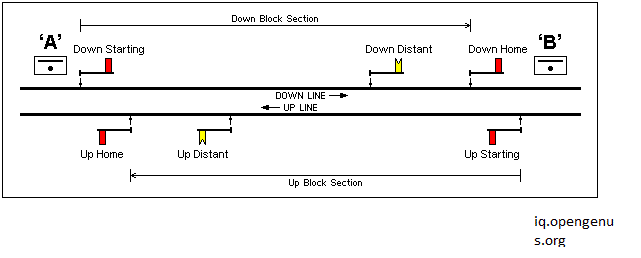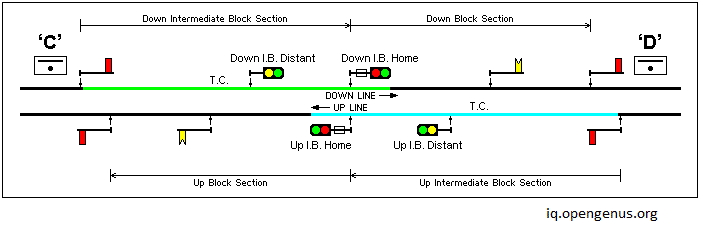
Open-Source Internship opportunity by OpenGenus for programmers. Apply now.
Indian Railways has always been a fascinating topic for me. Today, I will share how a train leaves a station and reach next adjacent station. The process of train leaving a station and reaching next adjacent station is called as block working.
There are three types of block working in Indian Railways. They are-
- Absolute Block working
- Absolute Block Working with Intermediate Block Signal
- Automatic Block Working
We will discuss them one by one first lets understand block section and block station

The above image shows block section as the section between two signals the signals represent the block station. It is the most simplest diagram I have found to explain you block section.In simple words the tracks between two station is known as block section. So now we will discuss about absolute block working in Indian Railways.
Absolute Block Working

In this system, only one train can enter the block section at a time and until this train has not reached the next station other train standing at the previous station cannot leave the station and enter into the block section. For this purpose station masters are employed in every station they will ensure that the train has completely arrived at their station by observing 'X' or 'LV' sign on last coach and block section is cleared. To understand this process deeply lets assume that 2 trains are waiting on station A they are Express-1 and Express-2 respectively.Express-1 has to be departed first.Lets understand this process pointwise
- Station master of station-A will seek line clear from station-B's station master with the help of his block instrument.
- Now station-B's station master will ensure if the block section between station-A and B is cleared and there is no rolling stock on it.
- Station master of Station-B will give line clear to station-A's station master with the help of his block instrument.
- Now station master of station-A will lower the signal for Express-A to leave.
- Express-A will leave the station-A and enter the block section. Untill the Express-A will reach Station-B Express-B will not leave the station-A.
- Express-A will reach station-B and station master of station-B will ensure the complete arrival of train and block section is cleared and will give message of train arrival to station-A's station master.
After recieving the message the station master will seek line clear from station-B for Express-B and this process continues.
Absolute Block Working with Intermediate Block Signal

Let us look at above example again where a train leaves the station-A and reaches station-B till that time no other trains are allowed to enter the block section. Lets say that the block section is very long so in this case the other train will have to wait for the Express-1 to clear the the block section so it will create an unnecessary delay to Express-B. Hence to resolve this issue this type of block working is employed. This is an extension of Absolute Block working. In this system a long block section is divided into 2 small block sections.The intermediate of both the sections is provided with Intermediate Block Signal (IBS). The IBS signal works as an unmanned station and it is operated by station master of rear station. The process is simple-
- Station master of station-A will take line clear from IBS signal and lower the signal for Express-A to go upto IBS signal.
- Before reaching IBS signal station master of Station-A will seek line clear from Station-B for lowering IBS signal for Express-A.
- After Express-A crosses IBS signal upto 400m station master can seek line clear from IBS signal to lower signal for Express-B to go upto the IBS signal.
In this way 2 trains can move in the same block section.This technique is also used where rail traffic is little busy.
Automatic Block Working
This technology is used in excessively busy sections where every minute a train passes.This system looks like the following.

In the above image, a complete block section is divided into small sections,entry to these sections is controlled by fully automatic stop signals mounted at a certain distance. The position of the signals are automatically controlled by the movement of the trains.Otherwise all the signals remain in green position.
Consider the four signals in the diagram are showing green. When the train approaches (shown as arrowhead) and crosses signal-1, it turns red. When the train crosses signal-2, it turns red but the signal-1 turns yellow.
When train crosses signal-3, it turns red,signal-2 turns yellow and signal-1 turns double yellow. When the train crosses signal-4, it turns red,signal-3 turns yellow, signal-2 turns double yellow and signal-1 turns green. This process continues untill all the signals of the block section turns green.
Thank you everyone for giving their valuable time in reading this article at OpenGenus.
